Study Skills for Higher Education: CSR and Workplace Equity Analysis
VerifiedAdded on 2021/01/01
|10
|2763
|15
Report
AI Summary
This report presents a literature review on Corporate Social Responsibility (CSR) and its relationship with workplace equity. The introduction defines CSR and its importance in modern business, emphasizing its impact on social, economic, and environmental aspects, as well as its role in promoting equality. The main body delves into the definition and objectives of a literature review, outlining its purpose and the skills required for effective research. It then explores various authors' views on CSR and its role in maintaining and improving equality in the workplace, including discussions on employee relations, organizational commitment, gender equity, and the benefits of CSR programs. The report highlights how CSR can attract talent, promote sustainable business practices, and create an environment where all employees are treated equally. The conclusion summarizes the key findings, emphasizing the importance of CSR for enhancing brand value and fostering positive relationships within the organization. The report integrates multiple perspectives, providing a comprehensive overview of the topic.
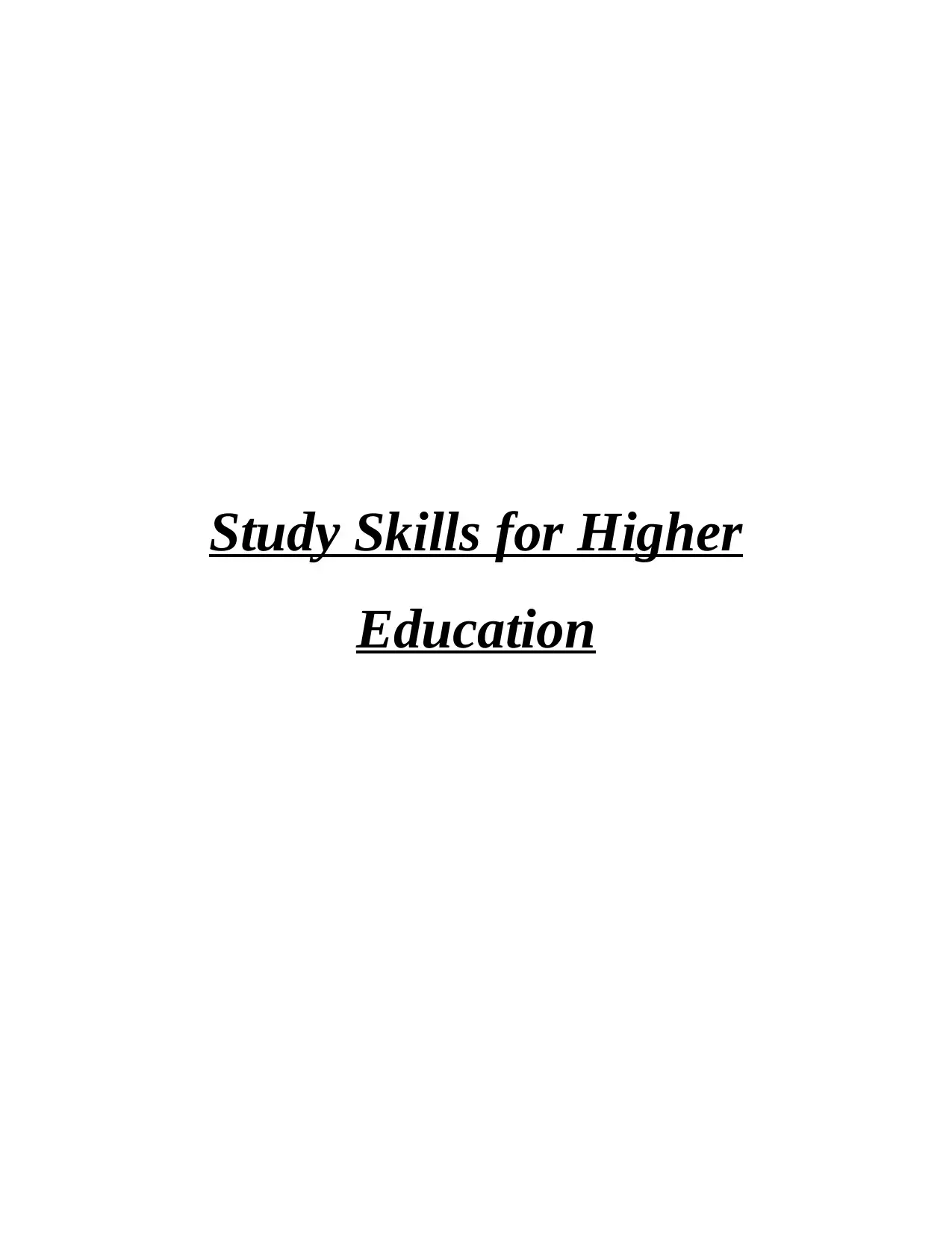
Study Skills for Higher
Education
Education
Paraphrase This Document
Need a fresh take? Get an instant paraphrase of this document with our AI Paraphraser
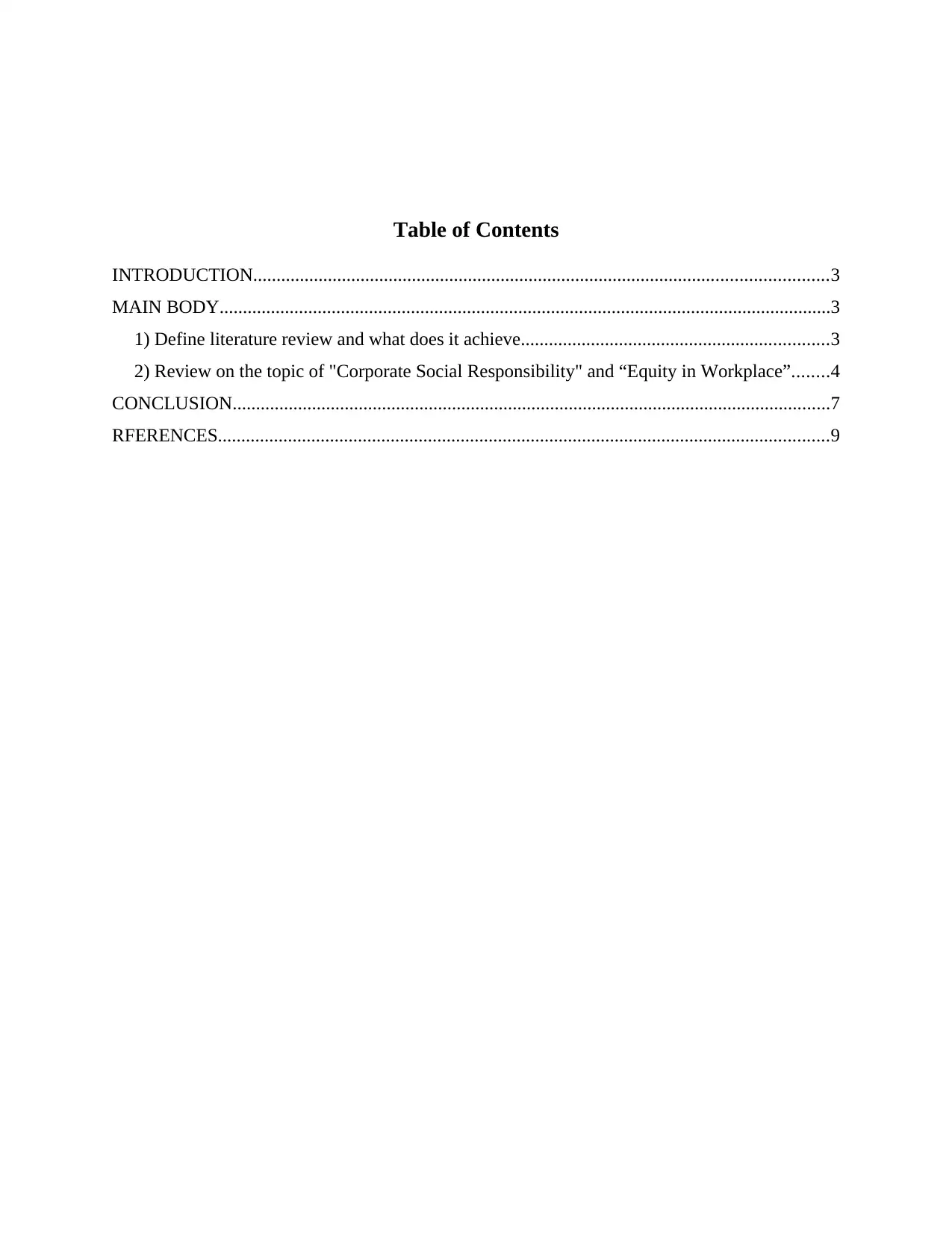
Table of Contents
INTRODUCTION...........................................................................................................................3
MAIN BODY...................................................................................................................................3
1) Define literature review and what does it achieve..................................................................3
2) Review on the topic of "Corporate Social Responsibility" and “Equity in Workplace”........4
CONCLUSION................................................................................................................................7
RFERENCES...................................................................................................................................9
INTRODUCTION...........................................................................................................................3
MAIN BODY...................................................................................................................................3
1) Define literature review and what does it achieve..................................................................3
2) Review on the topic of "Corporate Social Responsibility" and “Equity in Workplace”........4
CONCLUSION................................................................................................................................7
RFERENCES...................................................................................................................................9
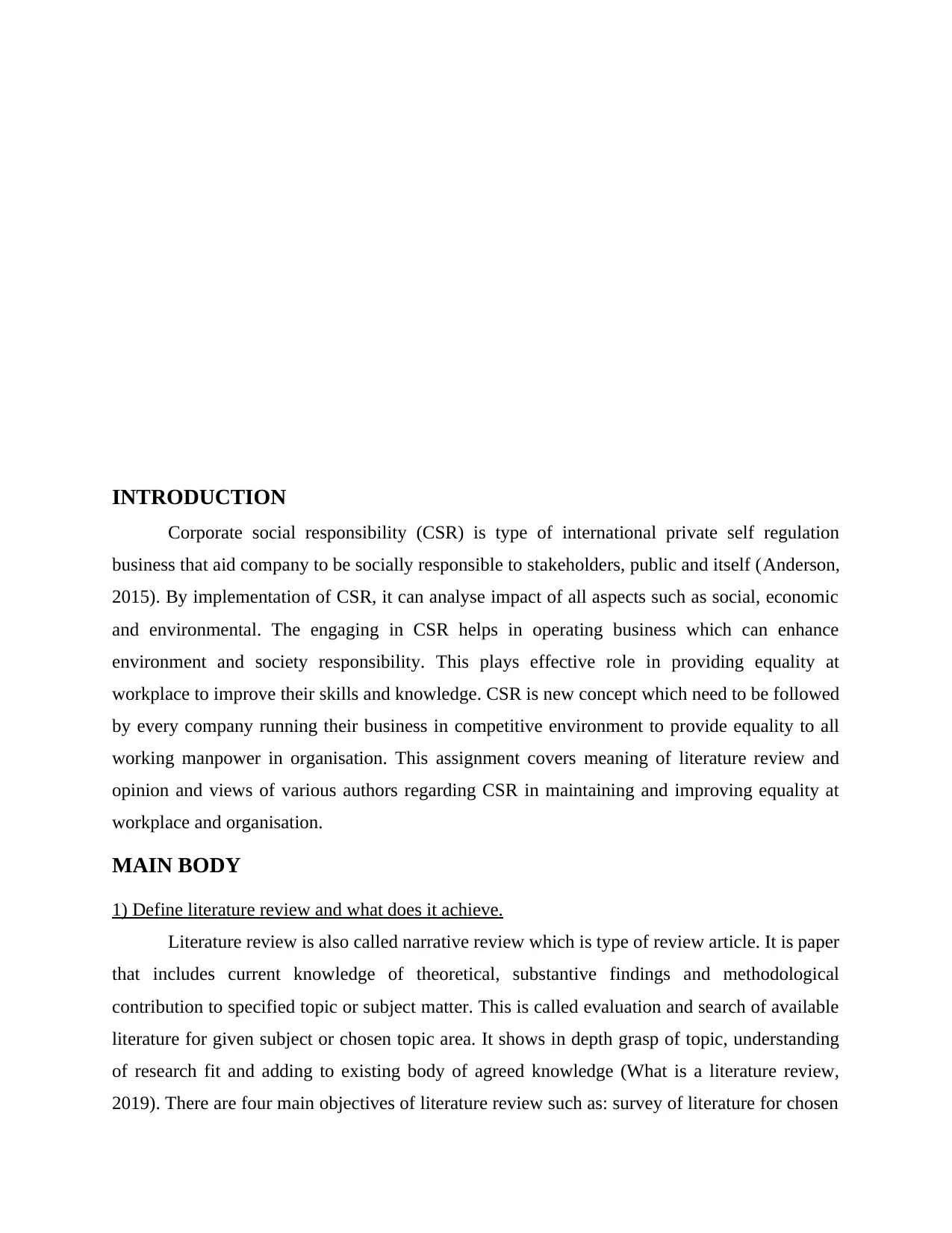
INTRODUCTION
Corporate social responsibility (CSR) is type of international private self regulation
business that aid company to be socially responsible to stakeholders, public and itself (Anderson,
2015). By implementation of CSR, it can analyse impact of all aspects such as social, economic
and environmental. The engaging in CSR helps in operating business which can enhance
environment and society responsibility. This plays effective role in providing equality at
workplace to improve their skills and knowledge. CSR is new concept which need to be followed
by every company running their business in competitive environment to provide equality to all
working manpower in organisation. This assignment covers meaning of literature review and
opinion and views of various authors regarding CSR in maintaining and improving equality at
workplace and organisation.
MAIN BODY
1) Define literature review and what does it achieve.
Literature review is also called narrative review which is type of review article. It is paper
that includes current knowledge of theoretical, substantive findings and methodological
contribution to specified topic or subject matter. This is called evaluation and search of available
literature for given subject or chosen topic area. It shows in depth grasp of topic, understanding
of research fit and adding to existing body of agreed knowledge (What is a literature review,
2019). There are four main objectives of literature review such as: survey of literature for chosen
Corporate social responsibility (CSR) is type of international private self regulation
business that aid company to be socially responsible to stakeholders, public and itself (Anderson,
2015). By implementation of CSR, it can analyse impact of all aspects such as social, economic
and environmental. The engaging in CSR helps in operating business which can enhance
environment and society responsibility. This plays effective role in providing equality at
workplace to improve their skills and knowledge. CSR is new concept which need to be followed
by every company running their business in competitive environment to provide equality to all
working manpower in organisation. This assignment covers meaning of literature review and
opinion and views of various authors regarding CSR in maintaining and improving equality at
workplace and organisation.
MAIN BODY
1) Define literature review and what does it achieve.
Literature review is also called narrative review which is type of review article. It is paper
that includes current knowledge of theoretical, substantive findings and methodological
contribution to specified topic or subject matter. This is called evaluation and search of available
literature for given subject or chosen topic area. It shows in depth grasp of topic, understanding
of research fit and adding to existing body of agreed knowledge (What is a literature review,
2019). There are four main objectives of literature review such as: survey of literature for chosen
⊘ This is a preview!⊘
Do you want full access?
Subscribe today to unlock all pages.

Trusted by 1+ million students worldwide
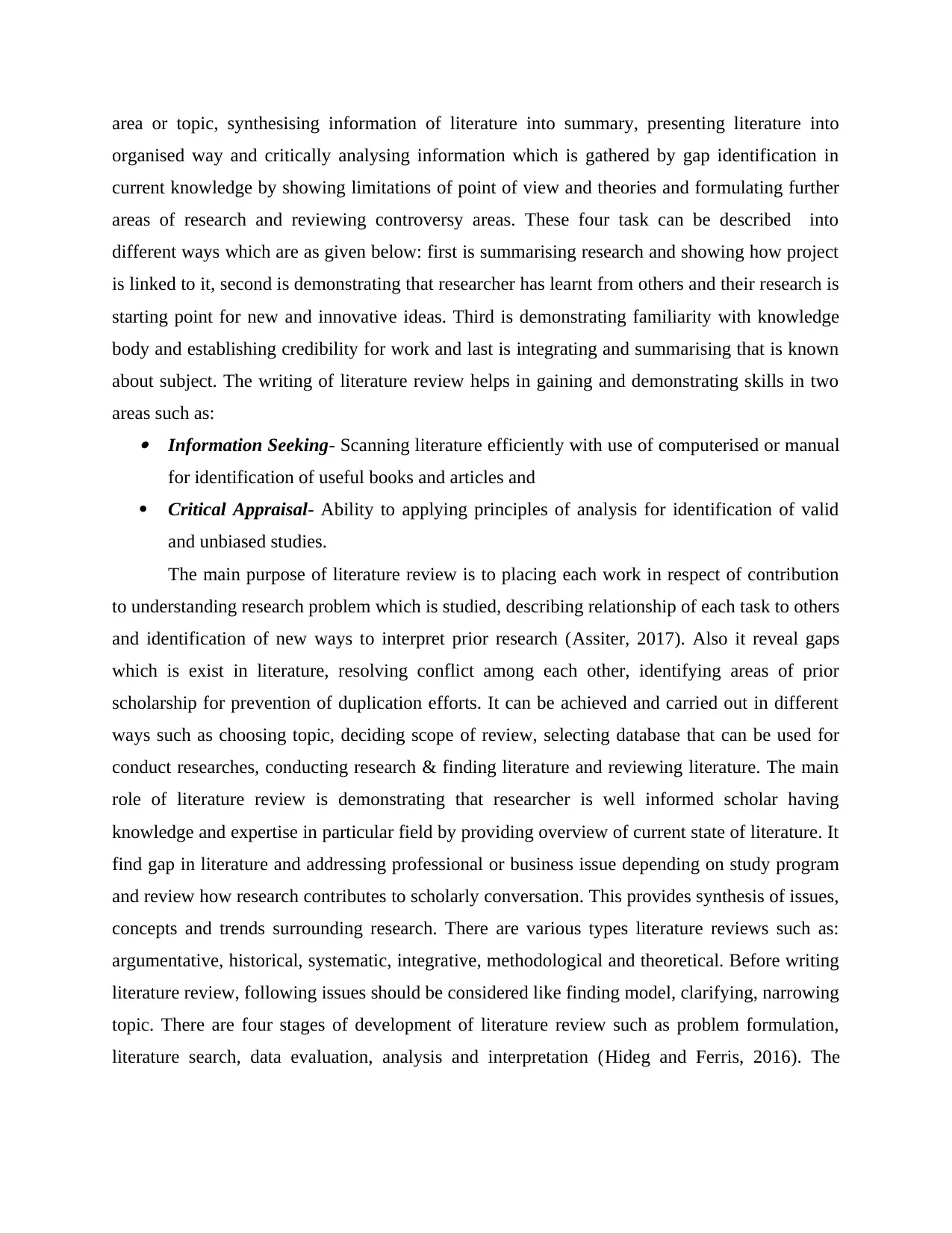
area or topic, synthesising information of literature into summary, presenting literature into
organised way and critically analysing information which is gathered by gap identification in
current knowledge by showing limitations of point of view and theories and formulating further
areas of research and reviewing controversy areas. These four task can be described into
different ways which are as given below: first is summarising research and showing how project
is linked to it, second is demonstrating that researcher has learnt from others and their research is
starting point for new and innovative ideas. Third is demonstrating familiarity with knowledge
body and establishing credibility for work and last is integrating and summarising that is known
about subject. The writing of literature review helps in gaining and demonstrating skills in two
areas such as: Information Seeking- Scanning literature efficiently with use of computerised or manual
for identification of useful books and articles and
Critical Appraisal- Ability to applying principles of analysis for identification of valid
and unbiased studies.
The main purpose of literature review is to placing each work in respect of contribution
to understanding research problem which is studied, describing relationship of each task to others
and identification of new ways to interpret prior research (Assiter, 2017). Also it reveal gaps
which is exist in literature, resolving conflict among each other, identifying areas of prior
scholarship for prevention of duplication efforts. It can be achieved and carried out in different
ways such as choosing topic, deciding scope of review, selecting database that can be used for
conduct researches, conducting research & finding literature and reviewing literature. The main
role of literature review is demonstrating that researcher is well informed scholar having
knowledge and expertise in particular field by providing overview of current state of literature. It
find gap in literature and addressing professional or business issue depending on study program
and review how research contributes to scholarly conversation. This provides synthesis of issues,
concepts and trends surrounding research. There are various types literature reviews such as:
argumentative, historical, systematic, integrative, methodological and theoretical. Before writing
literature review, following issues should be considered like finding model, clarifying, narrowing
topic. There are four stages of development of literature review such as problem formulation,
literature search, data evaluation, analysis and interpretation (Hideg and Ferris, 2016). The
organised way and critically analysing information which is gathered by gap identification in
current knowledge by showing limitations of point of view and theories and formulating further
areas of research and reviewing controversy areas. These four task can be described into
different ways which are as given below: first is summarising research and showing how project
is linked to it, second is demonstrating that researcher has learnt from others and their research is
starting point for new and innovative ideas. Third is demonstrating familiarity with knowledge
body and establishing credibility for work and last is integrating and summarising that is known
about subject. The writing of literature review helps in gaining and demonstrating skills in two
areas such as: Information Seeking- Scanning literature efficiently with use of computerised or manual
for identification of useful books and articles and
Critical Appraisal- Ability to applying principles of analysis for identification of valid
and unbiased studies.
The main purpose of literature review is to placing each work in respect of contribution
to understanding research problem which is studied, describing relationship of each task to others
and identification of new ways to interpret prior research (Assiter, 2017). Also it reveal gaps
which is exist in literature, resolving conflict among each other, identifying areas of prior
scholarship for prevention of duplication efforts. It can be achieved and carried out in different
ways such as choosing topic, deciding scope of review, selecting database that can be used for
conduct researches, conducting research & finding literature and reviewing literature. The main
role of literature review is demonstrating that researcher is well informed scholar having
knowledge and expertise in particular field by providing overview of current state of literature. It
find gap in literature and addressing professional or business issue depending on study program
and review how research contributes to scholarly conversation. This provides synthesis of issues,
concepts and trends surrounding research. There are various types literature reviews such as:
argumentative, historical, systematic, integrative, methodological and theoretical. Before writing
literature review, following issues should be considered like finding model, clarifying, narrowing
topic. There are four stages of development of literature review such as problem formulation,
literature search, data evaluation, analysis and interpretation (Hideg and Ferris, 2016). The
Paraphrase This Document
Need a fresh take? Get an instant paraphrase of this document with our AI Paraphraser
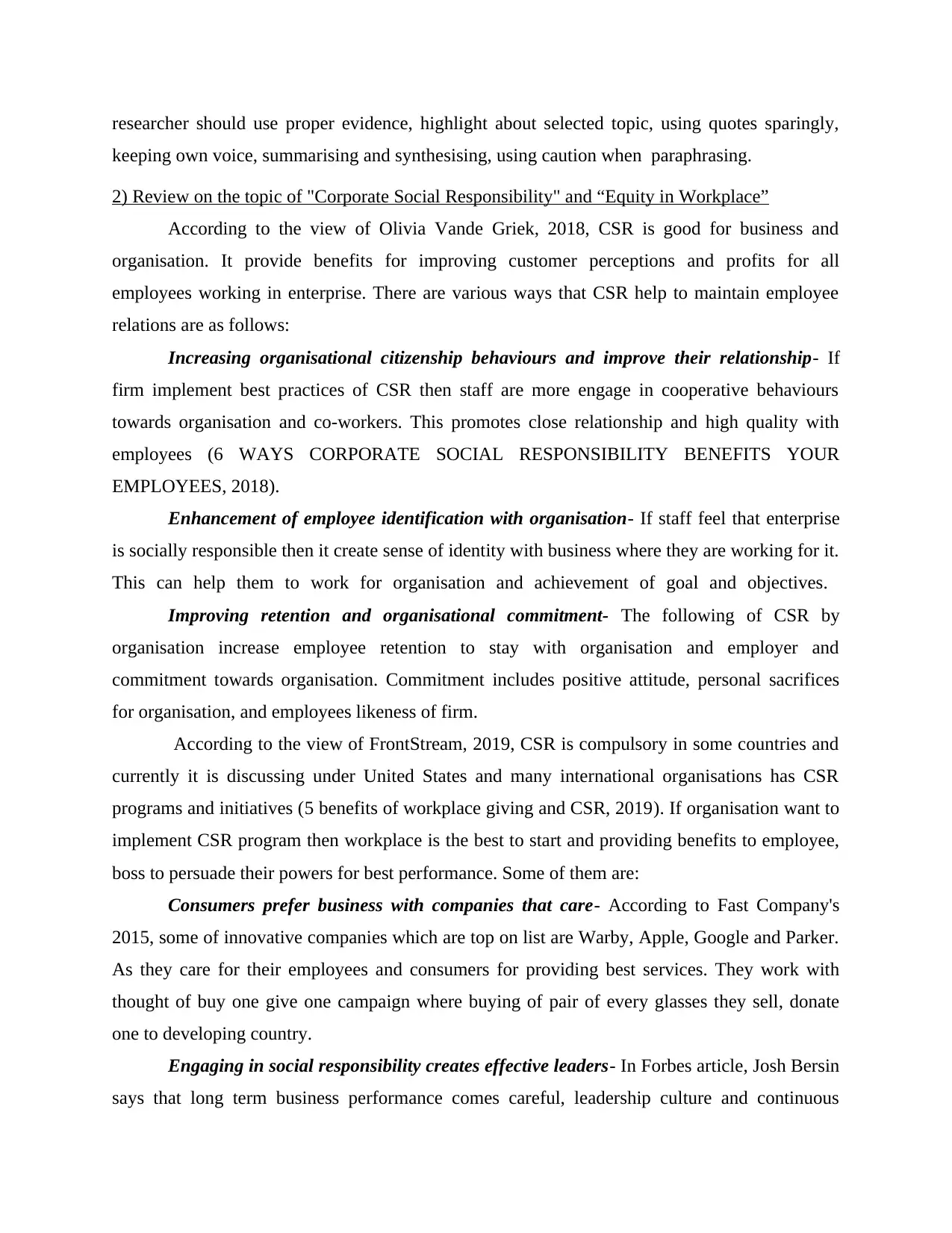
researcher should use proper evidence, highlight about selected topic, using quotes sparingly,
keeping own voice, summarising and synthesising, using caution when paraphrasing.
2) Review on the topic of "Corporate Social Responsibility" and “Equity in Workplace”
According to the view of Olivia Vande Griek, 2018, CSR is good for business and
organisation. It provide benefits for improving customer perceptions and profits for all
employees working in enterprise. There are various ways that CSR help to maintain employee
relations are as follows:
Increasing organisational citizenship behaviours and improve their relationship- If
firm implement best practices of CSR then staff are more engage in cooperative behaviours
towards organisation and co-workers. This promotes close relationship and high quality with
employees (6 WAYS CORPORATE SOCIAL RESPONSIBILITY BENEFITS YOUR
EMPLOYEES, 2018).
Enhancement of employee identification with organisation- If staff feel that enterprise
is socially responsible then it create sense of identity with business where they are working for it.
This can help them to work for organisation and achievement of goal and objectives.
Improving retention and organisational commitment- The following of CSR by
organisation increase employee retention to stay with organisation and employer and
commitment towards organisation. Commitment includes positive attitude, personal sacrifices
for organisation, and employees likeness of firm.
According to the view of FrontStream, 2019, CSR is compulsory in some countries and
currently it is discussing under United States and many international organisations has CSR
programs and initiatives (5 benefits of workplace giving and CSR, 2019). If organisation want to
implement CSR program then workplace is the best to start and providing benefits to employee,
boss to persuade their powers for best performance. Some of them are:
Consumers prefer business with companies that care- According to Fast Company's
2015, some of innovative companies which are top on list are Warby, Apple, Google and Parker.
As they care for their employees and consumers for providing best services. They work with
thought of buy one give one campaign where buying of pair of every glasses they sell, donate
one to developing country.
Engaging in social responsibility creates effective leaders- In Forbes article, Josh Bersin
says that long term business performance comes careful, leadership culture and continuous
keeping own voice, summarising and synthesising, using caution when paraphrasing.
2) Review on the topic of "Corporate Social Responsibility" and “Equity in Workplace”
According to the view of Olivia Vande Griek, 2018, CSR is good for business and
organisation. It provide benefits for improving customer perceptions and profits for all
employees working in enterprise. There are various ways that CSR help to maintain employee
relations are as follows:
Increasing organisational citizenship behaviours and improve their relationship- If
firm implement best practices of CSR then staff are more engage in cooperative behaviours
towards organisation and co-workers. This promotes close relationship and high quality with
employees (6 WAYS CORPORATE SOCIAL RESPONSIBILITY BENEFITS YOUR
EMPLOYEES, 2018).
Enhancement of employee identification with organisation- If staff feel that enterprise
is socially responsible then it create sense of identity with business where they are working for it.
This can help them to work for organisation and achievement of goal and objectives.
Improving retention and organisational commitment- The following of CSR by
organisation increase employee retention to stay with organisation and employer and
commitment towards organisation. Commitment includes positive attitude, personal sacrifices
for organisation, and employees likeness of firm.
According to the view of FrontStream, 2019, CSR is compulsory in some countries and
currently it is discussing under United States and many international organisations has CSR
programs and initiatives (5 benefits of workplace giving and CSR, 2019). If organisation want to
implement CSR program then workplace is the best to start and providing benefits to employee,
boss to persuade their powers for best performance. Some of them are:
Consumers prefer business with companies that care- According to Fast Company's
2015, some of innovative companies which are top on list are Warby, Apple, Google and Parker.
As they care for their employees and consumers for providing best services. They work with
thought of buy one give one campaign where buying of pair of every glasses they sell, donate
one to developing country.
Engaging in social responsibility creates effective leaders- In Forbes article, Josh Bersin
says that long term business performance comes careful, leadership culture and continuous
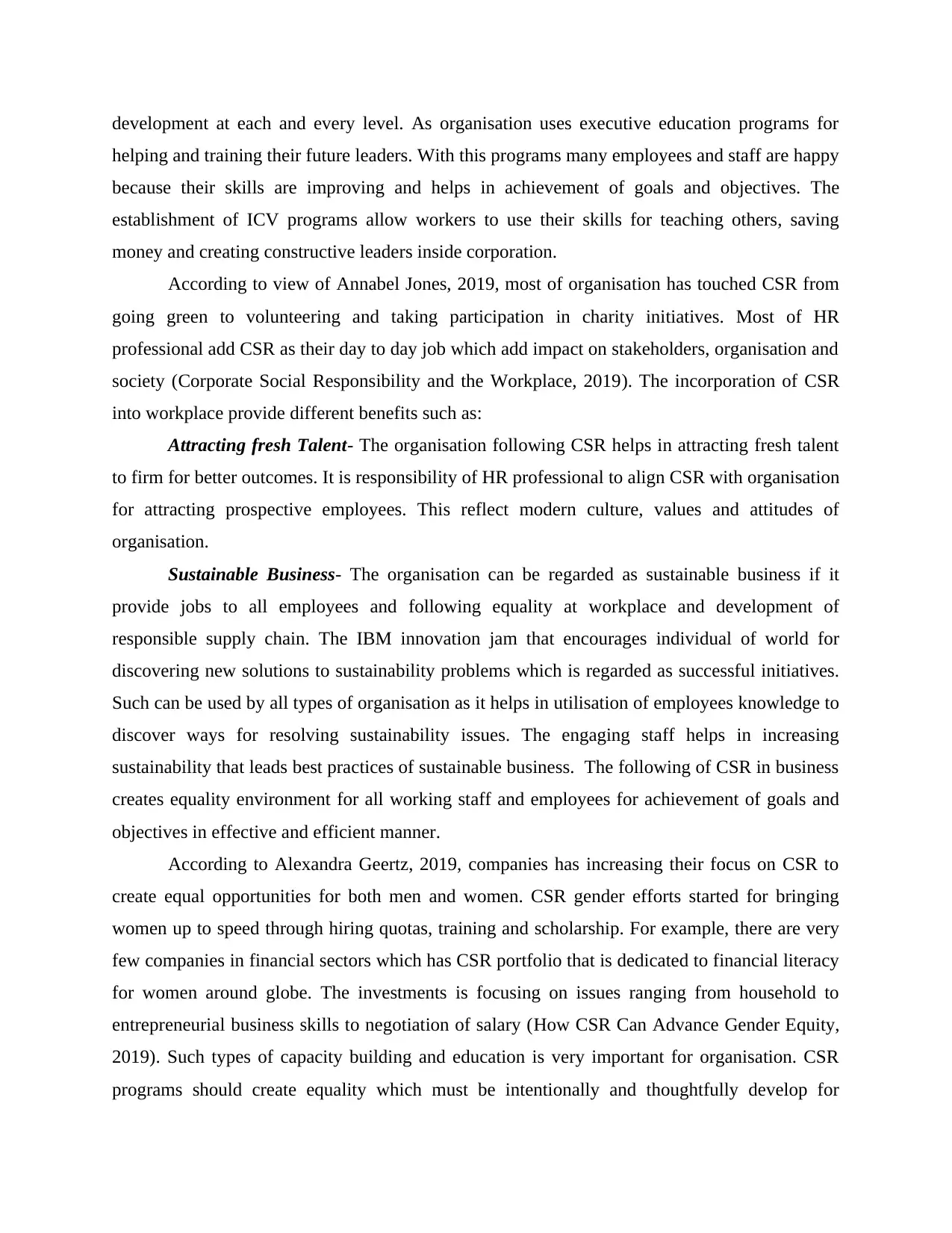
development at each and every level. As organisation uses executive education programs for
helping and training their future leaders. With this programs many employees and staff are happy
because their skills are improving and helps in achievement of goals and objectives. The
establishment of ICV programs allow workers to use their skills for teaching others, saving
money and creating constructive leaders inside corporation.
According to view of Annabel Jones, 2019, most of organisation has touched CSR from
going green to volunteering and taking participation in charity initiatives. Most of HR
professional add CSR as their day to day job which add impact on stakeholders, organisation and
society (Corporate Social Responsibility and the Workplace, 2019). The incorporation of CSR
into workplace provide different benefits such as:
Attracting fresh Talent- The organisation following CSR helps in attracting fresh talent
to firm for better outcomes. It is responsibility of HR professional to align CSR with organisation
for attracting prospective employees. This reflect modern culture, values and attitudes of
organisation.
Sustainable Business- The organisation can be regarded as sustainable business if it
provide jobs to all employees and following equality at workplace and development of
responsible supply chain. The IBM innovation jam that encourages individual of world for
discovering new solutions to sustainability problems which is regarded as successful initiatives.
Such can be used by all types of organisation as it helps in utilisation of employees knowledge to
discover ways for resolving sustainability issues. The engaging staff helps in increasing
sustainability that leads best practices of sustainable business. The following of CSR in business
creates equality environment for all working staff and employees for achievement of goals and
objectives in effective and efficient manner.
According to Alexandra Geertz, 2019, companies has increasing their focus on CSR to
create equal opportunities for both men and women. CSR gender efforts started for bringing
women up to speed through hiring quotas, training and scholarship. For example, there are very
few companies in financial sectors which has CSR portfolio that is dedicated to financial literacy
for women around globe. The investments is focusing on issues ranging from household to
entrepreneurial business skills to negotiation of salary (How CSR Can Advance Gender Equity,
2019). Such types of capacity building and education is very important for organisation. CSR
programs should create equality which must be intentionally and thoughtfully develop for
helping and training their future leaders. With this programs many employees and staff are happy
because their skills are improving and helps in achievement of goals and objectives. The
establishment of ICV programs allow workers to use their skills for teaching others, saving
money and creating constructive leaders inside corporation.
According to view of Annabel Jones, 2019, most of organisation has touched CSR from
going green to volunteering and taking participation in charity initiatives. Most of HR
professional add CSR as their day to day job which add impact on stakeholders, organisation and
society (Corporate Social Responsibility and the Workplace, 2019). The incorporation of CSR
into workplace provide different benefits such as:
Attracting fresh Talent- The organisation following CSR helps in attracting fresh talent
to firm for better outcomes. It is responsibility of HR professional to align CSR with organisation
for attracting prospective employees. This reflect modern culture, values and attitudes of
organisation.
Sustainable Business- The organisation can be regarded as sustainable business if it
provide jobs to all employees and following equality at workplace and development of
responsible supply chain. The IBM innovation jam that encourages individual of world for
discovering new solutions to sustainability problems which is regarded as successful initiatives.
Such can be used by all types of organisation as it helps in utilisation of employees knowledge to
discover ways for resolving sustainability issues. The engaging staff helps in increasing
sustainability that leads best practices of sustainable business. The following of CSR in business
creates equality environment for all working staff and employees for achievement of goals and
objectives in effective and efficient manner.
According to Alexandra Geertz, 2019, companies has increasing their focus on CSR to
create equal opportunities for both men and women. CSR gender efforts started for bringing
women up to speed through hiring quotas, training and scholarship. For example, there are very
few companies in financial sectors which has CSR portfolio that is dedicated to financial literacy
for women around globe. The investments is focusing on issues ranging from household to
entrepreneurial business skills to negotiation of salary (How CSR Can Advance Gender Equity,
2019). Such types of capacity building and education is very important for organisation. CSR
programs should create equality which must be intentionally and thoughtfully develop for
⊘ This is a preview!⊘
Do you want full access?
Subscribe today to unlock all pages.

Trusted by 1+ million students worldwide
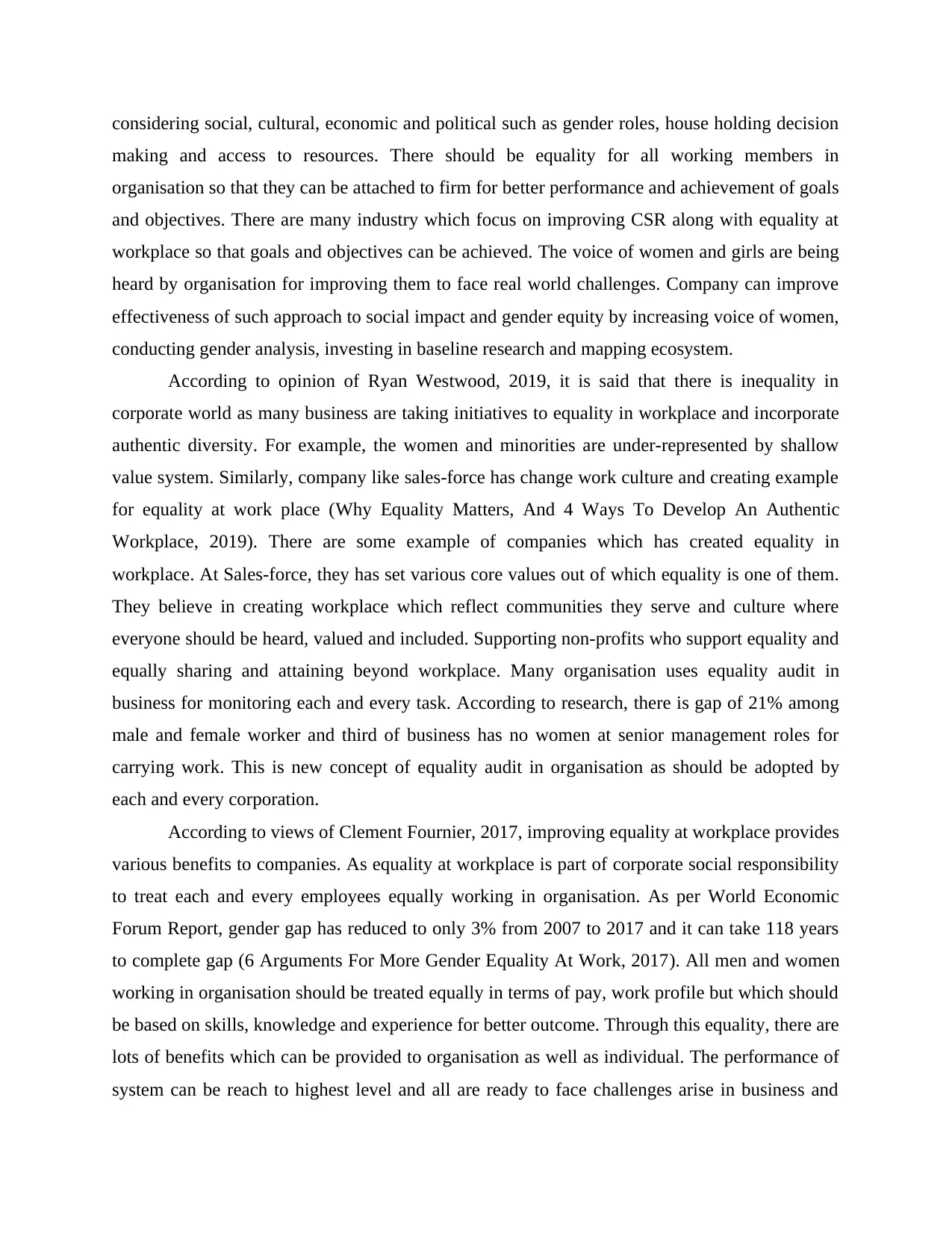
considering social, cultural, economic and political such as gender roles, house holding decision
making and access to resources. There should be equality for all working members in
organisation so that they can be attached to firm for better performance and achievement of goals
and objectives. There are many industry which focus on improving CSR along with equality at
workplace so that goals and objectives can be achieved. The voice of women and girls are being
heard by organisation for improving them to face real world challenges. Company can improve
effectiveness of such approach to social impact and gender equity by increasing voice of women,
conducting gender analysis, investing in baseline research and mapping ecosystem.
According to opinion of Ryan Westwood, 2019, it is said that there is inequality in
corporate world as many business are taking initiatives to equality in workplace and incorporate
authentic diversity. For example, the women and minorities are under-represented by shallow
value system. Similarly, company like sales-force has change work culture and creating example
for equality at work place (Why Equality Matters, And 4 Ways To Develop An Authentic
Workplace, 2019). There are some example of companies which has created equality in
workplace. At Sales-force, they has set various core values out of which equality is one of them.
They believe in creating workplace which reflect communities they serve and culture where
everyone should be heard, valued and included. Supporting non-profits who support equality and
equally sharing and attaining beyond workplace. Many organisation uses equality audit in
business for monitoring each and every task. According to research, there is gap of 21% among
male and female worker and third of business has no women at senior management roles for
carrying work. This is new concept of equality audit in organisation as should be adopted by
each and every corporation.
According to views of Clement Fournier, 2017, improving equality at workplace provides
various benefits to companies. As equality at workplace is part of corporate social responsibility
to treat each and every employees equally working in organisation. As per World Economic
Forum Report, gender gap has reduced to only 3% from 2007 to 2017 and it can take 118 years
to complete gap (6 Arguments For More Gender Equality At Work, 2017). All men and women
working in organisation should be treated equally in terms of pay, work profile but which should
be based on skills, knowledge and experience for better outcome. Through this equality, there are
lots of benefits which can be provided to organisation as well as individual. The performance of
system can be reach to highest level and all are ready to face challenges arise in business and
making and access to resources. There should be equality for all working members in
organisation so that they can be attached to firm for better performance and achievement of goals
and objectives. There are many industry which focus on improving CSR along with equality at
workplace so that goals and objectives can be achieved. The voice of women and girls are being
heard by organisation for improving them to face real world challenges. Company can improve
effectiveness of such approach to social impact and gender equity by increasing voice of women,
conducting gender analysis, investing in baseline research and mapping ecosystem.
According to opinion of Ryan Westwood, 2019, it is said that there is inequality in
corporate world as many business are taking initiatives to equality in workplace and incorporate
authentic diversity. For example, the women and minorities are under-represented by shallow
value system. Similarly, company like sales-force has change work culture and creating example
for equality at work place (Why Equality Matters, And 4 Ways To Develop An Authentic
Workplace, 2019). There are some example of companies which has created equality in
workplace. At Sales-force, they has set various core values out of which equality is one of them.
They believe in creating workplace which reflect communities they serve and culture where
everyone should be heard, valued and included. Supporting non-profits who support equality and
equally sharing and attaining beyond workplace. Many organisation uses equality audit in
business for monitoring each and every task. According to research, there is gap of 21% among
male and female worker and third of business has no women at senior management roles for
carrying work. This is new concept of equality audit in organisation as should be adopted by
each and every corporation.
According to views of Clement Fournier, 2017, improving equality at workplace provides
various benefits to companies. As equality at workplace is part of corporate social responsibility
to treat each and every employees equally working in organisation. As per World Economic
Forum Report, gender gap has reduced to only 3% from 2007 to 2017 and it can take 118 years
to complete gap (6 Arguments For More Gender Equality At Work, 2017). All men and women
working in organisation should be treated equally in terms of pay, work profile but which should
be based on skills, knowledge and experience for better outcome. Through this equality, there are
lots of benefits which can be provided to organisation as well as individual. The performance of
system can be reach to highest level and all are ready to face challenges arise in business and
Paraphrase This Document
Need a fresh take? Get an instant paraphrase of this document with our AI Paraphraser
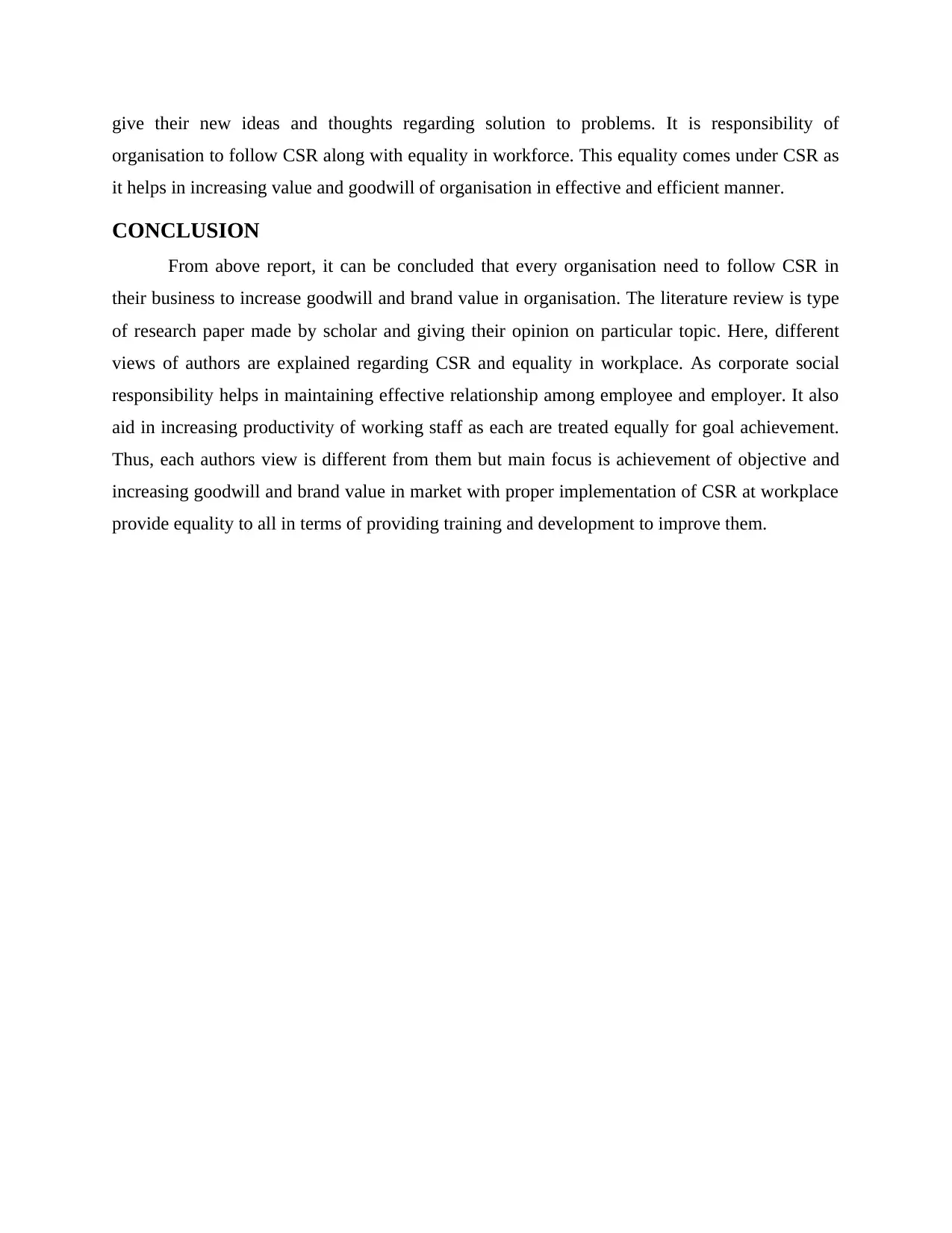
give their new ideas and thoughts regarding solution to problems. It is responsibility of
organisation to follow CSR along with equality in workforce. This equality comes under CSR as
it helps in increasing value and goodwill of organisation in effective and efficient manner.
CONCLUSION
From above report, it can be concluded that every organisation need to follow CSR in
their business to increase goodwill and brand value in organisation. The literature review is type
of research paper made by scholar and giving their opinion on particular topic. Here, different
views of authors are explained regarding CSR and equality in workplace. As corporate social
responsibility helps in maintaining effective relationship among employee and employer. It also
aid in increasing productivity of working staff as each are treated equally for goal achievement.
Thus, each authors view is different from them but main focus is achievement of objective and
increasing goodwill and brand value in market with proper implementation of CSR at workplace
provide equality to all in terms of providing training and development to improve them.
organisation to follow CSR along with equality in workforce. This equality comes under CSR as
it helps in increasing value and goodwill of organisation in effective and efficient manner.
CONCLUSION
From above report, it can be concluded that every organisation need to follow CSR in
their business to increase goodwill and brand value in organisation. The literature review is type
of research paper made by scholar and giving their opinion on particular topic. Here, different
views of authors are explained regarding CSR and equality in workplace. As corporate social
responsibility helps in maintaining effective relationship among employee and employer. It also
aid in increasing productivity of working staff as each are treated equally for goal achievement.
Thus, each authors view is different from them but main focus is achievement of objective and
increasing goodwill and brand value in market with proper implementation of CSR at workplace
provide equality to all in terms of providing training and development to improve them.
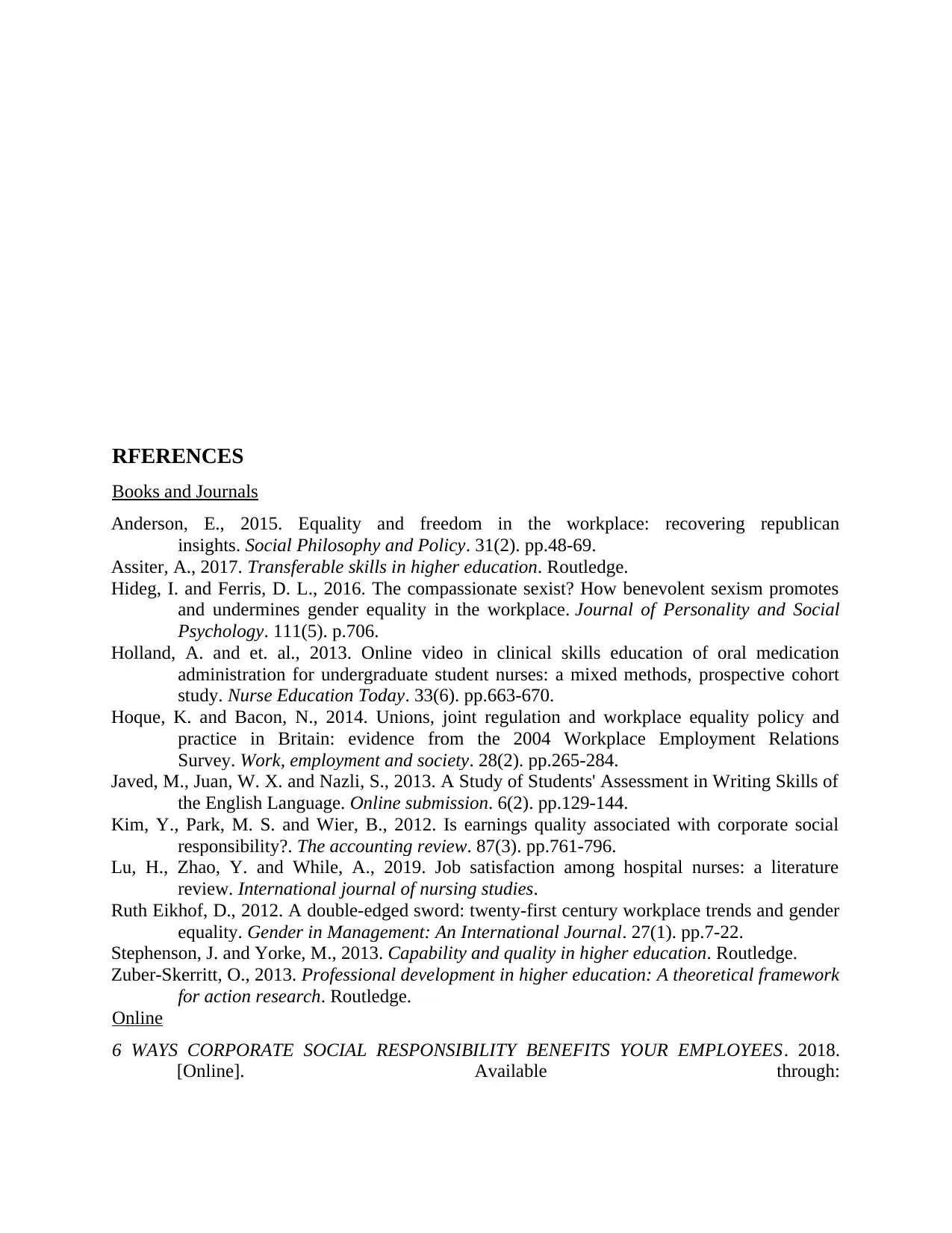
RFERENCES
Books and Journals
Anderson, E., 2015. Equality and freedom in the workplace: recovering republican
insights. Social Philosophy and Policy. 31(2). pp.48-69.
Assiter, A., 2017. Transferable skills in higher education. Routledge.
Hideg, I. and Ferris, D. L., 2016. The compassionate sexist? How benevolent sexism promotes
and undermines gender equality in the workplace. Journal of Personality and Social
Psychology. 111(5). p.706.
Holland, A. and et. al., 2013. Online video in clinical skills education of oral medication
administration for undergraduate student nurses: a mixed methods, prospective cohort
study. Nurse Education Today. 33(6). pp.663-670.
Hoque, K. and Bacon, N., 2014. Unions, joint regulation and workplace equality policy and
practice in Britain: evidence from the 2004 Workplace Employment Relations
Survey. Work, employment and society. 28(2). pp.265-284.
Javed, M., Juan, W. X. and Nazli, S., 2013. A Study of Students' Assessment in Writing Skills of
the English Language. Online submission. 6(2). pp.129-144.
Kim, Y., Park, M. S. and Wier, B., 2012. Is earnings quality associated with corporate social
responsibility?. The accounting review. 87(3). pp.761-796.
Lu, H., Zhao, Y. and While, A., 2019. Job satisfaction among hospital nurses: a literature
review. International journal of nursing studies.
Ruth Eikhof, D., 2012. A double-edged sword: twenty-first century workplace trends and gender
equality. Gender in Management: An International Journal. 27(1). pp.7-22.
Stephenson, J. and Yorke, M., 2013. Capability and quality in higher education. Routledge.
Zuber-Skerritt, O., 2013. Professional development in higher education: A theoretical framework
for action research. Routledge.
Online
6 WAYS CORPORATE SOCIAL RESPONSIBILITY BENEFITS YOUR EMPLOYEES. 2018.
[Online]. Available through:
Books and Journals
Anderson, E., 2015. Equality and freedom in the workplace: recovering republican
insights. Social Philosophy and Policy. 31(2). pp.48-69.
Assiter, A., 2017. Transferable skills in higher education. Routledge.
Hideg, I. and Ferris, D. L., 2016. The compassionate sexist? How benevolent sexism promotes
and undermines gender equality in the workplace. Journal of Personality and Social
Psychology. 111(5). p.706.
Holland, A. and et. al., 2013. Online video in clinical skills education of oral medication
administration for undergraduate student nurses: a mixed methods, prospective cohort
study. Nurse Education Today. 33(6). pp.663-670.
Hoque, K. and Bacon, N., 2014. Unions, joint regulation and workplace equality policy and
practice in Britain: evidence from the 2004 Workplace Employment Relations
Survey. Work, employment and society. 28(2). pp.265-284.
Javed, M., Juan, W. X. and Nazli, S., 2013. A Study of Students' Assessment in Writing Skills of
the English Language. Online submission. 6(2). pp.129-144.
Kim, Y., Park, M. S. and Wier, B., 2012. Is earnings quality associated with corporate social
responsibility?. The accounting review. 87(3). pp.761-796.
Lu, H., Zhao, Y. and While, A., 2019. Job satisfaction among hospital nurses: a literature
review. International journal of nursing studies.
Ruth Eikhof, D., 2012. A double-edged sword: twenty-first century workplace trends and gender
equality. Gender in Management: An International Journal. 27(1). pp.7-22.
Stephenson, J. and Yorke, M., 2013. Capability and quality in higher education. Routledge.
Zuber-Skerritt, O., 2013. Professional development in higher education: A theoretical framework
for action research. Routledge.
Online
6 WAYS CORPORATE SOCIAL RESPONSIBILITY BENEFITS YOUR EMPLOYEES. 2018.
[Online]. Available through:
⊘ This is a preview!⊘
Do you want full access?
Subscribe today to unlock all pages.

Trusted by 1+ million students worldwide
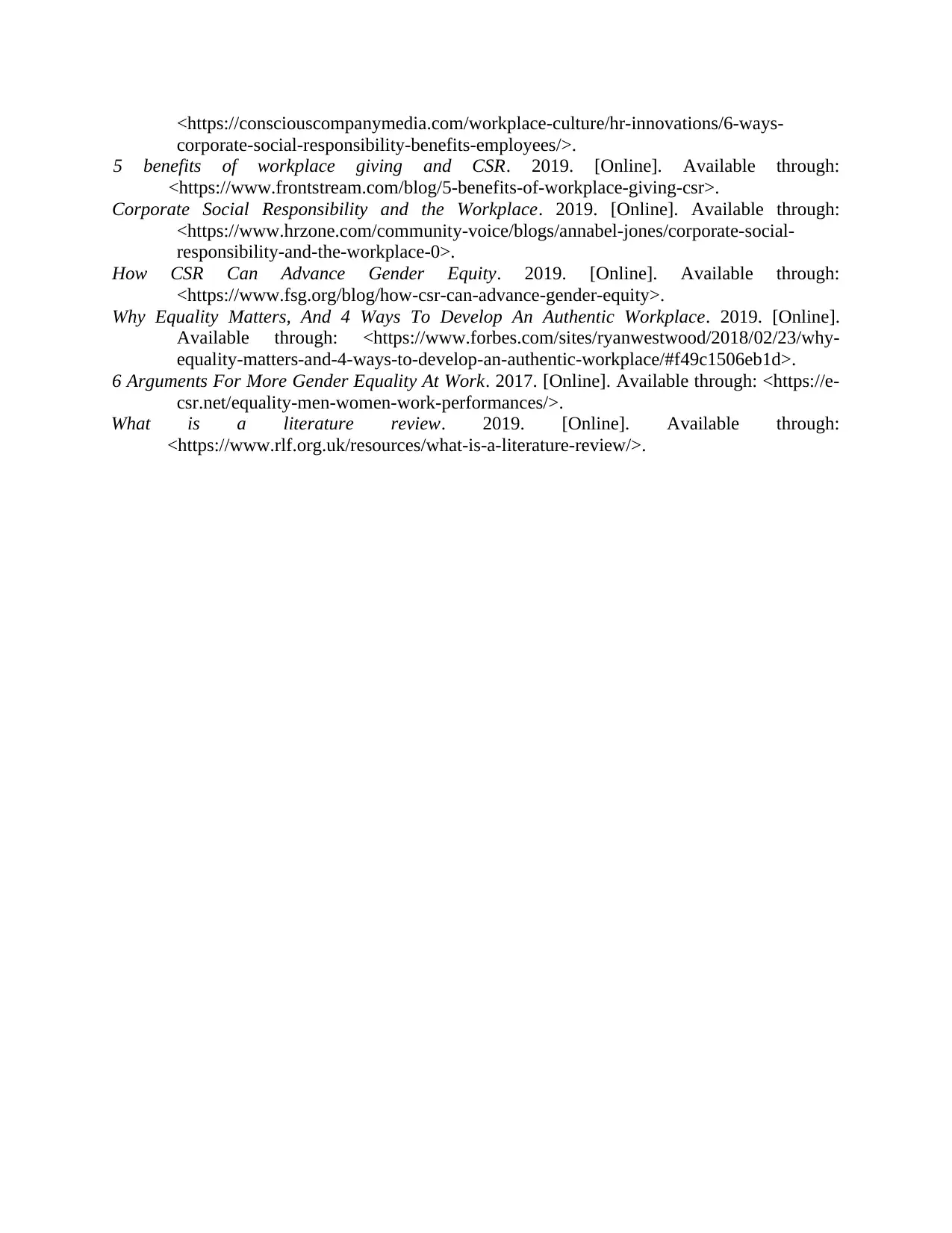
<https://consciouscompanymedia.com/workplace-culture/hr-innovations/6-ways-
corporate-social-responsibility-benefits-employees/>.
5 benefits of workplace giving and CSR. 2019. [Online]. Available through:
<https://www.frontstream.com/blog/5-benefits-of-workplace-giving-csr>.
Corporate Social Responsibility and the Workplace. 2019. [Online]. Available through:
<https://www.hrzone.com/community-voice/blogs/annabel-jones/corporate-social-
responsibility-and-the-workplace-0>.
How CSR Can Advance Gender Equity. 2019. [Online]. Available through:
<https://www.fsg.org/blog/how-csr-can-advance-gender-equity>.
Why Equality Matters, And 4 Ways To Develop An Authentic Workplace. 2019. [Online].
Available through: <https://www.forbes.com/sites/ryanwestwood/2018/02/23/why-
equality-matters-and-4-ways-to-develop-an-authentic-workplace/#f49c1506eb1d>.
6 Arguments For More Gender Equality At Work. 2017. [Online]. Available through: <https://e-
csr.net/equality-men-women-work-performances/>.
What is a literature review. 2019. [Online]. Available through:
<https://www.rlf.org.uk/resources/what-is-a-literature-review/>.
corporate-social-responsibility-benefits-employees/>.
5 benefits of workplace giving and CSR. 2019. [Online]. Available through:
<https://www.frontstream.com/blog/5-benefits-of-workplace-giving-csr>.
Corporate Social Responsibility and the Workplace. 2019. [Online]. Available through:
<https://www.hrzone.com/community-voice/blogs/annabel-jones/corporate-social-
responsibility-and-the-workplace-0>.
How CSR Can Advance Gender Equity. 2019. [Online]. Available through:
<https://www.fsg.org/blog/how-csr-can-advance-gender-equity>.
Why Equality Matters, And 4 Ways To Develop An Authentic Workplace. 2019. [Online].
Available through: <https://www.forbes.com/sites/ryanwestwood/2018/02/23/why-
equality-matters-and-4-ways-to-develop-an-authentic-workplace/#f49c1506eb1d>.
6 Arguments For More Gender Equality At Work. 2017. [Online]. Available through: <https://e-
csr.net/equality-men-women-work-performances/>.
What is a literature review. 2019. [Online]. Available through:
<https://www.rlf.org.uk/resources/what-is-a-literature-review/>.
1 out of 10
Related Documents
Your All-in-One AI-Powered Toolkit for Academic Success.
+13062052269
info@desklib.com
Available 24*7 on WhatsApp / Email
![[object Object]](/_next/static/media/star-bottom.7253800d.svg)
Unlock your academic potential
Copyright © 2020–2025 A2Z Services. All Rights Reserved. Developed and managed by ZUCOL.





